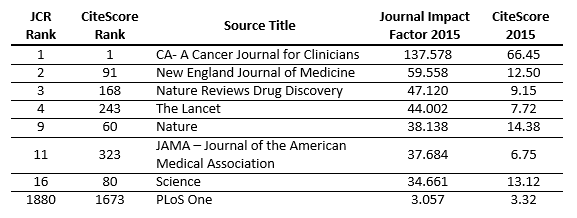By: Karen Gutzman, Impact and Evaluation Librarian
Journal-based metrics can help determine the overall quality of a communication channel. A key metric for many years has been the Journal Impact Factor by Clarivate Analytics (formerly Thomson Reuters). In December 2016, Elsevier introduced a comparative metric called CiteScore, which is part of a family of journal-based metrics.
How is it calculated?
The 2015 CitesScore is calculated by dividing the total number of citations in 2015 to documents published in the 3 previous years, by the number of documents published in those same 3 years.

How does CiteScore differ from Journal Impact Factor?
Though CiteScore is similar to the Journal Impact Factor (JIF), the two differ in some key areas:
Timeframe. The JIF counts documents (in denominator) and citations (in numerator) over a 2 year period, whereas CiteScore uses a 3 year timeframe. Elsevier explains that the wider citation window allows for a fairer evaluation of all fields, including those that take longer to accumulate citations. Clarivate Analytics would point to their 5-Year Impact Factor in response to this, which is included in the Journal Citation Reports.
Citable items. Both the JIF and CiteScore cast a wide net for their numerator by counting all the citations made to a journal title. However, they differ greatly in what they include in the denominator. JIF counts only documents published in the journal that are considered substantive and scholarly – namely articles, reviews and proceedings papers. Whereas, CiteScore counts all document types in the denominator, including editorials, letters to the editor, etc. Journals that have more diversity in document types (i.e. fewer articles and reviews) are more likely to have a lower CiteScore when compared to JIF.
Comparison. Below is a side-by-side comparison of several top journals based on JIF. For example, the high impact journal JAMA, has a JIF of 37.68, and a CiteScore of 6.75 in 2015.

Timely Release. Both the JIF and CiteScore are based on data from the previous full year (i.e. we’re currently working with 2015 data for both JIF and CiteScore). Official scores for 2016 for JIF will be released in the summer, and CiteScore in the spring. However, CiteScore keeps up a CiteScoreTracker which calculates the current year’s scores (i.e. 2016) on a monthly basis prior to the official upcoming release.
Availability. CiteScore is made freely available, while Journal Citation Reports is available through subscription. Galter Health Sciences Library provides quick access to both from our website.
Range. In 2015 there were almost twice as many journals with a CiteScore (22,044 journals) when compared to JIF (11,985 journals).
Review of Quality: Both Elsevier and Clarivate Analytics have an ongoing journal evaluation process (see Elsevier’s here, and Clarivate’s here and here), though it’s difficult to tell how much they differ in their methods.
Is there room for CiteScore?
Some have argued that CiteScore is subject to potential conflicts of interest because Elsevier also publishes a significant number of journals (approximately 1,462 journals) that are ranked by the metric. Others have suggested that including all document types in the denominator acts as a disincentive to journals in publishing a diversity of materials and lowers the quality of the metric. While these are appropriate concerns, there’s also the practical need to measure journal quality. CiteScore’s impressive range means that even more journals (which have gone through a quality selection process) receive a score that helps us evaluate their work.
Further Information
- Bergstrom CT, West J. Comparing Impact Factor and Scopus CiteScore. Available from http://eigenfactor.org/projects/posts/citescore.php
- Elsevier. What is CiteScore? Available from https://help.elsevier.com/app/answers/detail/a_id/5247/p/8150
- Hubbard SC, McVeigh ME. Casting A Wide Net: The Journal Impact Factor Numerator. Learned Publishing. 2011. 24: 133-137. doi:10.1087/20110208
- McVeigh ME, Mann SJ. The Journal Impact Factor Denominator Defining Citable (Counted) Items. JAMA-Journal of the American Medical Association 2009. Sep;302(10):1107-9.
- Waltman, L. Q &A on Elsevier’s CiteScore metric. Available from https://www.cwts.nl/blog?article=n-q2y254
- Ziljlstra H, McCullough R. CiteScore: a new metric to help you track journal performance and make decisions. 2016. Available from https://www.elsevier.com/editors-update/story/journal-metrics/citescore-a-new-metric-to-help-you-choose-the-right-journal
Updated: September 25, 2023